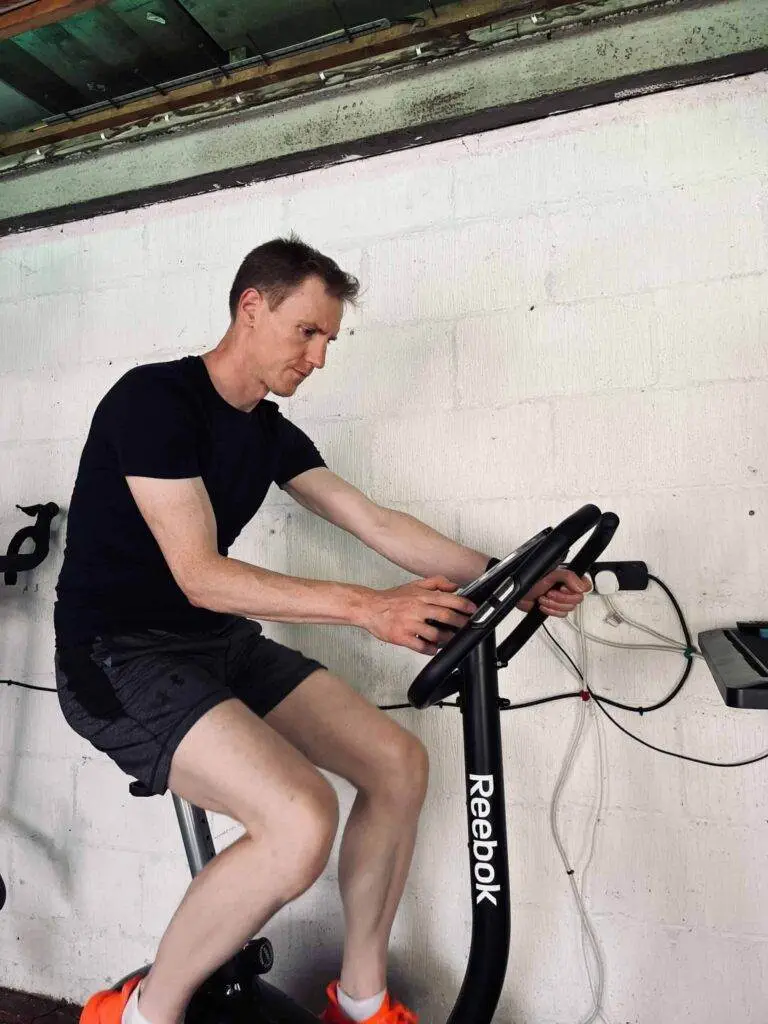When it comes to the biking equivalent of running a mile, things can get overly complicated very quickly.
But have no fear – we’re here to help. In this article, we’re looking at factors affecting equivalents, the benefits of cycling, and some tips for getting your cycle journey started.
Key Takeaways: What is the Biking Equivalent of Running a Mile?
- Various external factors affect the biking equivalent of running a mile.
- Generally, there is a 1:3 ratio for biking and running equivalents.
- Cycling can be better for joint health and muscle recovery.
- Wind resistance can impact the calculation for the biking equivalent of running a mile.
- Practical tip: ease into your cycling journey gradually to avoid injury.

Factors that Affect the Biking Equivalent of Running a Mile
Before we get into the calculations, it helps to understand the factors that might affect them:
- Intensity: The intensity of your running or bike workout affects things significantly. Running is a weight-bearing exercise that requires more effort. In other words, you’ll burn more calories running than you would be cycling if you looked at your workout duration.
- Setting: Where you exercise plays a role in the effort level needed. For example; running up a hill requires much more energy than running on a flat road. So, remember to take this into consideration when you compare your run and bike training.
- Speed: Bike miles require less energy than running miles. You also cover much more ground on a bike than with running.
- Wind resistance: The wind plays an important role in your overall performance. Resistance is far greater when you’re cycling into a headwind, making it more difficult to maintain your pace. Cycling into the wind uses more energy, even at a moderate pace, so you won’t have as much of an energy reserve.
- Equipment: Your cycling equipment plays a significant role in your energy expenditure. A mountain bike is also very different from a road bike in terms of weight and required exertion.
- Body weight and fitness level: In general, the more you weigh, the more energy you need, whether you’re running miles or cycling.
How to Calculate the Biking Equivalent of Running a Mile
Generally, comparing bike miles to running works on a 1:3 ratio. In other words, one mile of running is equivalent to approximately three cycling miles.
Exact calculations and formulae vary and can be quite complicated. A 100% accurate result would have to factor in calories, speed, and Metabolic Equivalent of Task (MET) – among other things! So it might be better to stick with a 1:3 ratio.
An easier way to work out bike miles to running is to look at how many calories you burn. Using a fitness tracker, cycle for one mile and look at the calories burned. Once you have that, you simply run until you hit the same number of burned calories. That should give you a more personalized indication of the running equivalent of cycling in miles.
Top tip: Head to a gym and jump on a stationary bike. Once you’ve ridden a mile and know how many calories you’ve burned, jump on the treadmill. Both pieces of equipment should have digital readings, making it easier to measure variables like energy expenditure.

Benefits of Biking vs. Running
If you’re considering running and cycling together to achieve your fitness goals, there are some things to take into consideration first:
- Calories expenditure: Running miles generally burns more calories than cycling the same distance, because you’re relying solely on your body. So, if you want to lose weight, a running program might get you there faster. For example, one running mile burns 100 calories on average, whereas cycling is about 50-60 calories.
- Joint stress: Running puts a lot more pressure on joints than cycling. This means a higher chance of injury and the recovery time that comes with it.
- Muscle building: Cycling is better for building major muscle groups in the lower body and can also help your core and shoulders. Running is better for burning calories in terms of duration and distance (relevant if you’re trying to lose weight), while cycling is good for burning calories while building leg muscles.
- Better for injury: Cycling can be better for athletes with specific injuries. Running generally has jerking movements, and the impact puts stress on muscles and joints throughout your entire body. Cycling is more fluid, making it a better option for muscle recovery.

Tips for Incorporating Biking into Your Exercise Routine
Before you head out on your bike, here are some useful tips:
- Find the right equipment: Whether you want to do indoor or outdoor training will determine what kind of bike you need. Look for the best quality bike within your budget and space availability in the home.
- Start gradually: We don’t recommend riding into the sunset at full speed. Slow and steady wins the race; start with less cycling distance and build up gradually.
- Warm-up: It’s important to warm up your muscles before any type of exercise. A ten-minute low-resistance warm-up and ten minutes of dynamic stretches are a must before hitting the tarmac.
- Safety first: It should go without saying: a helmet is non-negotiable. Always ensure you have the right safety equipment before going cycling.

Biking Resources and Tools
Starting a cycle routine is exciting – there are so many things to learn along the way. If you’re looking for help in understanding the average speed for cycling, our guide to the average cycling speed by age can help.
Guidelines on how to improve cycling speed and endurance come in super handy when you want to boost your cycling performance.
FAQs
Can I switch between running and biking for cross-training purposes?
Yes! Switching between the two for cross-training provides variety, meaning less chance of injury and overuse of the same muscle groups.
Can equivalents vary between individuals?
Yes, that’s why working out your biking equivalent to running a mile may be beneficial.
